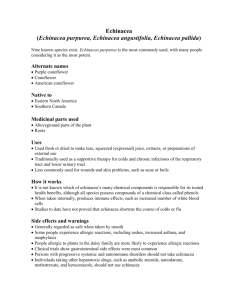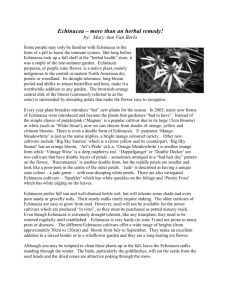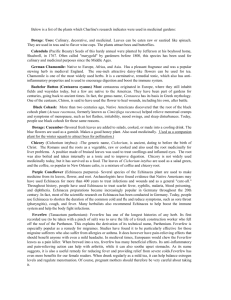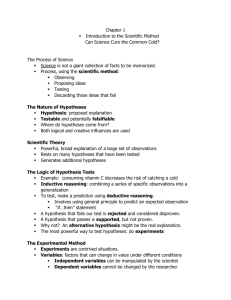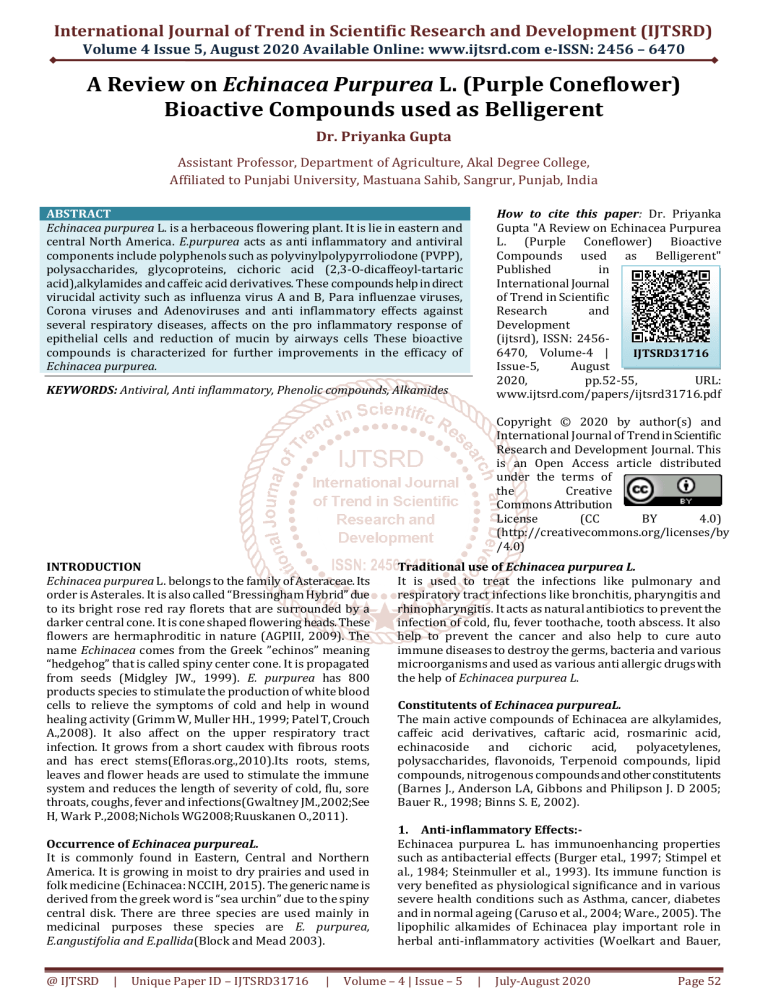
International Journal of Trend in Scientific Research and Development (IJTSRD)
Volume 4 Issue 5, August 2020 Available Online: www.ijtsrd.com e-ISSN: 2456 – 6470
A Review on Echinacea Purpurea L. (Purple Coneflower)
Bioactive Compounds used as Belligerent
Dr. Priyanka Gupta
Assistant Professor, Department of Agriculture, Akal Degree College,
Affiliated to Punjabi University, Mastuana Sahib, Sangrur, Punjab, India
ABSTRACT
Echinacea purpurea L. is a herbaceous flowering plant. It is lie in eastern and
central North America. E.purpurea acts as anti inflammatory and antiviral
components include polyphenols such as polyvinylpolypyrroliodone (PVPP),
polysaccharides, glycoproteins, cichoric acid (2,3-O-dicaffeoyl-tartaric
acid),alkylamides and caffeic acid derivatives. These compounds help in direct
virucidal activity such as influenza virus A and B, Para influenzae viruses,
Corona viruses and Adenoviruses and anti inflammatory effects against
several respiratory diseases, affects on the pro inflammatory response of
epithelial cells and reduction of mucin by airways cells These bioactive
compounds is characterized for further improvements in the efficacy of
Echinacea purpurea.
How to cite this paper: Dr. Priyanka
Gupta "A Review on Echinacea Purpurea
L. (Purple Coneflower) Bioactive
Compounds used as Belligerent"
Published
in
International Journal
of Trend in Scientific
Research
and
Development
(ijtsrd), ISSN: 24566470, Volume-4 |
IJTSRD31716
Issue-5,
August
2020,
pp.52-55,
URL:
www.ijtsrd.com/papers/ijtsrd31716.pdf
KEYWORDS: Antiviral, Anti inflammatory, Phenolic compounds, Alkamides
Copyright © 2020 by author(s) and
International Journal of Trend in Scientific
Research and Development Journal. This
is an Open Access article distributed
under the terms of
the
Creative
Commons Attribution
License
(CC
BY
4.0)
(http://creativecommons.org/licenses/by
/4.0)
INTRODUCTION
Echinacea purpurea L. belongs to the family of Asteraceae. Its
order is Asterales. It is also called “Bressingham Hybrid” due
to its bright rose red ray florets that are surrounded by a
darker central cone. It is cone shaped flowering heads. These
flowers are hermaphroditic in nature (AGPIII, 2009). The
name Echinacea comes from the Greek ”echinos” meaning
“hedgehog” that is called spiny center cone. It is propagated
from seeds (Midgley JW., 1999). E. purpurea has 800
products species to stimulate the production of white blood
cells to relieve the symptoms of cold and help in wound
healing activity (Grimm W, Muller HH., 1999; Patel T, Crouch
A.,2008). It also affect on the upper respiratory tract
infection. It grows from a short caudex with fibrous roots
and has erect stems(Efloras.org.,2010).Its roots, stems,
leaves and flower heads are used to stimulate the immune
system and reduces the length of severity of cold, flu, sore
throats, coughs, fever and infections(Gwaltney JM.,2002;See
H, Wark P.,2008;Nichols WG2008;Ruuskanen O.,2011).
Occurrence of Echinacea purpureaL.
It is commonly found in Eastern, Central and Northern
America. It is growing in moist to dry prairies and used in
folk medicine (Echinacea: NCCIH, 2015). The generic name is
derived from the greek word is “sea urchin” due to the spiny
central disk. There are three species are used mainly in
medicinal purposes these species are E. purpurea,
E.angustifolia and E.pallida(Block and Mead 2003).
@ IJTSRD
|
Unique Paper ID – IJTSRD31716
|
Traditional use of Echinacea purpurea L.
It is used to treat the infections like pulmonary and
respiratory tract infections like bronchitis, pharyngitis and
rhinopharyngitis. It acts as natural antibiotics to prevent the
infection of cold, flu, fever toothache, tooth abscess. It also
help to prevent the cancer and also help to cure auto
immune diseases to destroy the germs, bacteria and various
microorganisms and used as various anti allergic drugs with
the help of Echinacea purpurea L.
Constitutents of Echinacea purpureaL.
The main active compounds of Echinacea are alkylamides,
caffeic acid derivatives, caftaric acid, rosmarinic acid,
echinacoside and cichoric acid,
polyacetylenes,
polysaccharides, flavonoids, Terpenoid compounds, lipid
compounds, nitrogenous compounds and other constitutents
(Barnes J., Anderson LA, Gibbons and Philipson J. D 2005;
Bauer R., 1998; Binns S. E, 2002).
1. Anti-inflammatory Effects:Echinacea purpurea L. has immunoenhancing properties
such as antibacterial effects (Burger etal., 1997; Stimpel et
al., 1984; Steinmuller et al., 1993). Its immune function is
very benefited as physiological significance and in various
severe health conditions such as Asthma, cancer, diabetes
and in normal ageing (Caruso et al., 2004; Ware., 2005). The
lipophilic alkamides of Echinacea play important role in
herbal anti-inflammatory activities (Woelkart and Bauer,
Volume – 4 | Issue – 5
|
July-August 2020
Page 52
International Journal of Trend in Scientific Research and Development (IJTSRD) @ www.ijtsrd.com eISSN: 2456-6470
2007). The alkamides from its roots extract help in
formation of human neuroglioma cells through decreased
cyclooxygenase-2 activity but alkamides increased COX-3 m
RNA and protein expression. They also play important role
in regulation of signal transduction pathways and
inflammatory responses (Hinz et al., 2007).It also acts as
immune stimulating properties to stimulate the
macrophages and neutrophils to produce inflammatory
cytokines and reactive oxygen species (Luettig etal., 1989;
Burger et al., 1997; Stimpel et al., 1984; Rininger et al.,
2000). The alkamides enhanced the physiological
parameters such as blood pressure, increased the tolerance
against pathogens, it modulate the immune response (Vos
AP etal., 2007;Delgado GTC etal.,2010).
2. Antiviral properties:Echinacea has antiviral activity to increase the rate of viral
antigens in cultured cells. Echinacea hydrophilic and
lipophilic extracts has more inhibitor components of viral
infection to prevent viral replication (Kumar et al.,2011).The
derivatives of Echinacea has potent activity against Influenza
virus and Anti-herpes virus activity (Vilmalanatham
etal.,2005;Hudson.,2012). Echinacea has strong inhibitory
activity against HIV that is caused by caffeic acid derivatives
and Cichoric acid helps to inhibits the HIV replication (Birt et
al., 2008).
There is the viral respiratory disease of zoonotic origin that
is caused by SARS that is called Severe acute respiratory
syndrome. Echinacea prevents Coronavirus (SARS-CoV) due
to its veridicial properties effectively because it has
calicivirus is sensitive to Echinacea (Hudson., 2012). Its
preparation effective as prophylactic treatment for all CoVs.
There are seven CoVs that have been found to cause disease
in humans in which four of those are non-zoonotic. These are
HcoV-229E, HcoV-OC43, HcoV-NL63 and HcoV-HKU1.
Antiviral herbal actions required the Haemagglutin
inhibition and Neuraminidase inhibition is to prevent the
viral replication, surface spike protein inhibition is to
prevent the viral entry, increasing interferon is to boost
natural immunity, inhibit the cytokine storm is to prevent
the inflammatory cascade effect (Liu Q, Zhou YH etal., 2015).
There are other viruses which is involved in the generation
of
respiratory
symptoms
these
viruses
are
metapneumoviruses and baculoviruses (Nichols WG
etal.,2008).Some diseases are pandemics that is
accompanied by innate immune response with the secretion
of cytokines and inflammatory mediators(Suzuki Y. 2009;
Michaelis M etal., 2009; Neumann G etal., 2009). E.purpurea
aerial parts or roots has potent antiviral activities aganist
herpes simplex virus and coronavirus were distributed more
than one solvent derived fraction to reflect more than
antiviral compounds (Hudson J. etal, 2005; Vimalanathan S
etal., 2005). Mostly E. purpurea were able to complete
stimulation of Rhinoviruses cytokines .These cytokines are
IL-1, 6, 8 and TNF-α (Sharma M., 2009; Hudson JB., 2010;
Sharma M etal., 2006).
In human 18 mucin genes are highly glycosylated
macromolecules to constitute the part of innate defense
system against respiratory pathogens (Vimalanathan S.,
2009). Certain chronic conditions of rhinovirus induce hyper
secrete mucins one or more genes These genes are MUC5A
(Sharma M, Schoop R etal., 2010).
@ IJTSRD
|
Unique Paper ID – IJTSRD31716
|
3. Antibacterial Properties:The use of E. purpurea extract has a prophylactic effect on
the development of Pseudomonas aeruginosa infection to
diminish the bacterial number in livers of C57B1/6 and
B6C3F1 stains and stimulation of granulocytes
chemiluminescent and lymphocytes proliferative responses
(Bany Jetal., 2003). E.purpurea also help to inactivate the
respiratory bacteria in epithelial cells. It also helps in the
inhibition of growth of trypanosomatids: these are
Leishmania donovani, Leshmania major and Trypanosoma
brucei L. These three species are found in human bronchial
epithelial cells and skin fibroblasts (RoeslerJ etal., 1991).
E. purpurea alkamides also help inhibition of the growth of
several yeasts such as Saccharomyces cerevisiae, Candida
shehata, C. albicans, C.tropicals. These alkamides disrupt the
cell walls and cell membranes of fungal pathogens (Cruz I.,
2014).
4. Anticancer Properties:E. purpurea hexanic roots help to inhibit the growth of
tumour of colon that is COLO320 cancer cell lines.
E.purpurea flower extract cichoric acid show the inhibitory
effect on the proliferation of human colon cancer cells CACO2 and HCT-116 effectively affect on colon cancer (Cech NB
etal., 2010).
5. Antifungal Properties:The extract of E. purpurea show antifungal activity against
Candida species and S. cerevisiae (Binns SE etal., 2000).The
polysaccharides of this extract help to decrease the infection
and death of Candida stains that is found in vaginal infection.
(Coeugniet et etal., 1986).
6. Antioxidant Properties:It is the most potent antioxidant activity.Arachidonic acid
metabolism and prostaglandin E2 production was reduced.
Caffeic acid derivatives are effective for antioxidants in free
radical systems and antihyaluronidase activity (DalbyBrownL. etal.,2002).
7. Conclusion:Echinacea is the most important species that has more
herbal medicinal value that is used in treatment of various
diseases. These plants possess several pharmacological
properties and has huge amount of phytochemical
compounds that is used in pharmaceutical industries to
produce more drugs for the treatment of several diseases. It
is highly famous immunostimulant herb taken for the
common cold and flu and in SARS diseases. It is also used in
macrophage stimulation and producing more antigen
specific immunoglobulins. The present study encompasses
the advantage of using the above plant in further researches
and their medicinal value and its pharmacological actions of
Echinacea purpurea L.
8. References:[1] Angiosperm Phylogeny Group:”An update of the
Angiosperm Phylogeny Group classification for the
orders and families of flowering plants: APGIII,
Botanical Journal of the Linnean Society,2:105121.2009.
[2] J. W. Midgley Southeastern Wildflowers: Your complete
guide to plant communities, identification and
traditional uses. Crane Hill Publishera. 1999.
Volume – 4 | Issue – 5
|
July-August 2020
Page 53
International Journal of Trend in Scientific Research and Development (IJTSRD) @ www.ijtsrd.com eISSN: 2456-6470
[3] W. Grimm, H. H. A Muller Randomized controlled trial
of the effect of fluid extract of Echinacea purpurea on
the Incidence and Severity of colds and respiratory
infections. American Journal of Medicine; 106(2):13843.1999
[4] T. Patel, A. Crouch, K. Dowless, D. Freier: Acute effects
of oral administration of a glycerol extract of Echinacea
purpurea on peritoneal exudates cells in female swiss
mice. Brain Behav Immun., 22-39.2008.
[5] Echinacea in Flora of North America@”Efloras.
Org.Retrieved, 02-01, 2010.
[6] J. M Gwaltney: Virology and Immunology of the
common cold. Rhinology; 23:265-271, 1985
[7] H See and P Wark:”Innate immune response to viral
infection of the lungs,” Paediatric Respiratory Reviews;
vol.9, no.4, pp243-250, 2008.
[8] W. G. Nicholas, A. J. Peck Campbell and Boeckhm:
“Respiratory viruses other than influenza virus: impact
and therapeutic advances”, Clinical Microbiology
Reviews, vol.21. no.4, pp 274-290, 2008.
[9] O. E. Ruuskanen, L. C. Lathi,, Jennings and D. R.
Murdoch, ”Viral pneumonia,” The Lancet, vol.377,
no.9773, pp1264-1275,2011.
[10] Echinacea. Natural Medicibes Website Accessed at
natural medicies. Therapeutic research.com.,2015.
[11] K. I. Block and Mead MN: Immune system effects of
Echinacea, ginseng and astragalus: a review. Integr
Cancer Ther, 2(3):247-267.2003.
[12] J. Barnes, L. AAnderson, Gibbons and J. D. Philipson:
Echinacea species Hell., Echinacea pallid (Nutt.) Nutt.,
Echinacea purpurea (L.)Moench): A Review of their
Chemistry, Pharamacology and Clinical Properties:
Journal of Pharmacy and Pharmacology, 57, 929-954,
2005.
[13] R. Bauer. Echinacea: Biological effects and active
properties, in L. D. Lawson, and R. Bauer. Eds.
Phytomedicines of Europe: Chemistry and Biological
Activity: American Chemical Society, Washington DC,
pp140-157, 1998.
[14] S. E. Binns, J. F. Livesey J. F, Arnason JT, Antiviral
activity of characteristized extracts from Echinacea
spp. against Herpes simplex virus (HSV-1). Planta Med,
68(9):780-783, 2002.
[15] R. A. Burger, A. R Torres, R. P. Warren, V. D. Caldwell, B.
G. Hughes: Echinacea-induced cytokine production by
human macrophages. Int. J. Immunopharmacol, 19(7):
371-378, 1997.
[16] M. Stimpel, A. Proksch, H. Wagner, M. L. LohmannMatthes: Macrophage activation and induction of
macrophage cytotoxicity by purified polysaccharide
fractions from the plant Echinacea purpurea infect
immune, 46(3):845-849, 1984.
[17] C. Steinmuller, J. Roesler, E. Grottrup, G. Franke, H.
Wagner, M. L. Lohmann-Matthes: Polysaccharides
isolated from cell culture of Echinacea purpurea
enhance the resistance of immune suppressed
immunopharmacol, 15(5):605-614,1993.
@ IJTSRD
|
Unique Paper ID – IJTSRD31716
|
[18] D. R. Caruso, J. D. Mayer, P. Salovey: Emotional
intelligence: Theory, finding and implications.
Psychological Inquiry, 15(3), 197-215, 2004.
[19] W. R. Ware: Inflammation- a double –edged sword,
International Health News Issues, 155-157, 2005.
[20] Woelkart and Bauer: The role of alkamides as an active
principle of Echinacea, Planta Medica, 73, 615-623,
2004.
[21] B. Hinz, K. Woelkart, R Bauer: Alkamides from
Echinacea inhibit cyclooxygenase-2 activity in human
neuroglioma
cells.
Biochem
Biophys
Res
Commun.360:441-446, 2007.
[22] B. C. Luettig, G. E. Steinmuller, H Gifford, M. L. Wagner,
Lohmann Matthes: Macrophage activation by the
polysacchaide arabinogalacton isolated from plant cell
culture of Echinacea purpurea . J. Nat. Cancer Institute,
81:669-675, 1989.
[23] J. A. Rininger, S. Kiekner, P. Chigurupati, A. Mclean, A
and Z Franck: Immunopharmalogical activity of
Echinacea preparations following stimulated digestion
on marine marophages and human peripheral blood
mononuclear cells. J. Leuk.Biolo., 68, 503-510, 2000.
[24] A. P. Vos etal: Immunol.,: 27(2):97-140.,2007.
[25] G. T. C Delgado, W. Tamashiro, G. M Pastore.
Immunomodulatory effects of frucyans. Food Res. Int:
43: 1231-1236, 2010.
[26] K. M. Kumar, S. Ramaiah S: Pharmacological
importance of Echinacea purpurea. Int J Pharm Biol.
Sci2: 305-314, 2011.
[27] S. Vimalanathan, etal: Pharm Biol., 12:43(9):740-745,
2005.
[28] J. B. Hudson: Applications of the Phytomedicine
Echinacea Purpuerea in infectious Diseases. J. Biomed
Biotechnol.769896, 2012.
[29] Birt etal: D. F. Birt, M. P. Widrlechner. C. A. Lalone, WU
l, J. Bae, A. K. S. Solco etal., Echinacea in infection.
American Journal of Clinical Nutrition, 87(2):488-492,
2008.
[30] Q. Liu, Y. H. Zhou and Z. Qiu yang Z: The cytokine storm
of severe influenza and development of
immunomodulatory therapy,: 13,3-10,2015.
[31] W. G. Nicholas WG, A. J. P. Campbell M. Boeckh:
Respiratory viruses other than influenza virus Impact
and therapeutic advances. Clin. Microbiol. Rev, 21:274290, 2008.
[32] Y. Suzuk ,”The highly pathogenic avian influenza H5N1initial molecular signals for the next influenza
pandemic,” Chang Gung MedicaL Journal, vol.32,n.3,pp
258-263,2009.
[33] M. Michaelis, H.W Doerr and J. Cinatl J, “Novel swineorigin influenza A virus in humans: another pandemic
knocking at the door”, Medical Microbiology and
Immunology, vol. 198, no.3, pp.175-183, 2009.
[34] G. Neumann, T. Nota and Y. Kawaoka:”Emergence and
pandemic potential of swine-origin H1NI influenza
virus,” Nature, vol.459, no7249, pp 931-939, 2009.
Volume – 4 | Issue – 5
|
July-August 2020
Page 54
International Journal of Trend in Scientific Research and Development (IJTSRD) @ www.ijtsrd.com eISSN: 2456-6470
[35] J. Hudson, S. Viimalanathan, L. Kang L., Amiguet, J.
Livesey J. T., Arnason JT: Characteristization of antiviral
activities in Echinacea root preparations. Pharm. Biol:
43: 790-796, 2005.
[36] M. Sharma M., S. A Anderson SA, R. Schoop, J. B. Hudson
JB: Induction of pro-imflammatory cytokines by
respiratory viruses and reversal by standaridized
Echinacea, a potent antiviral herbal extract Antiviral.
Res., 83: 165-170.2009.
[37] J. B. Hudson: The multiple actions of the phytomedicine
Echinacea in the treatment of cold and flu, Journal of
Medicinal Plant Research.Vol.4, no.25, pp.2746-2752,
2010.
[38] M. Sharma., J. T. Arnason, J. B. Hudson JB: Echinacea
extractsa modulate the production of multiple
transcription factors in uninfected cells and rhinovirus
cells. Phytother. Res.2.:20:1074-1079,2006.
[39] S. Vimalanathan, J. T. Arnason, J. B. Hudson: Antiinflammatory activities of Echinacea extracta do not
correlate with traditional marker components. Pharm.
Biol, 47:430-435, 2009.
[40] M. Sharma, R. Schoop R and JB Hudson: The efficacy of
Echinacea in a 3-D tissue model of human airway
epithelium, Phytotherapy Research, vol.24, no.6, pp
900-904, 2010.
[41] J. Bany, A. K. Z. Siwicki, D. danowska: Echinacea
purpurea stimulates cellular immunity and antibacterial defense independently of the strain of mice.
Pol J Vet Sci. 2; 6(3):3-5, 2003.
@ IJTSRD
|
Unique Paper ID – IJTSRD31716
|
[42] J. Roesler, C. Steinmuller, A. Kiderlen, A. Emmenforfer,
H. Wagner, M. L. Lohmann-Matthes: Application of
purified polysaccharides from cell cultures of the plant
Echinacea purpurea to mice mediates protection
against Systemic infections with Listeria Monocytoges
an Candida albicans. International Journal of
Immunopharmacology, 13:27-37, 1991.
[43] I. Cruz, J. J. Cheetham, J. T. Arnason, J. E. Yack, M. L.
Smith: Alkamides from Echinacea disrupt the Fungal
cellwall- Membrane Complex. Phytomedicines, 21(4),
435-442, 2014.
[44] N. B. Cech., V. Kandhi. J. M. Davis, A. D. Hamilton Eads,
and S. M. Laster ”Echinacea and its alkylamides: effects
on the influenza A-induced secretion of cytokines,
chymokines and PGE2 from RAW 264.7macrophagelike cells ”International Immuno pharmacology, vol.10,
no.10, pp 1268-1278.,2010.
[45] S. E. Binns, B. Purgina, C. Beergeron C etal:”Lightmediated antifungal activity of Echinacea extracts,”
Planta Medica, vol.66, no.3, pp241-244, 2000.
[46] E. Coeugniet, R. Kuhnast R. Recurrent candidiasis:
Adjuvant immunotherapy with different formulations
of Echinacin (TM). T herapiewocje, 36:, 3352-3358,
1986.
[47] L. Dalby-Brown, H. Barsett, A. K. Landbo, A. S. Meyer
and P Molgaard P: Sunergestic and oxidative effects of
alkamides, caffeic acid derivatives and polysaccharide
fractions from Echinacea purpurea on invitro oxidation
of human low density lipoprotein. J. Agric Food Chem,
53:265-272, 2002.
Volume – 4 | Issue – 5
|
July-August 2020
Page 55


